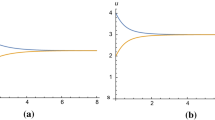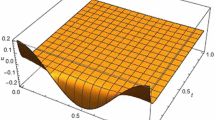Abstract
We propose and investigate a general class of discrete time and finite state space mean field game (MFG) problems with potential structure. Our model incorporates interactions through a congestion term and a price variable. It also allows hard constraints on the distribution of the agents. We analyze the connection between the MFG problem and two optimal control problems in duality. We present two families of numerical methods and detail their implementation: (i) primal-dual proximal methods (and their extension with nonlinear proximity operators), (ii) the alternating direction method of multipliers (ADMM) and a variant called ADM-G. We give some convergence results. Numerical results are provided for two examples with hard constraints.






Similar content being viewed by others
References
Achdou, Y., Camilli, F., Capuzzo-Dolcetta, I.: Mean field games: numerical methods for the planning problem. SIAM J. Control Optim. 50(1), 77–109 (2012)
Achdou, Y., Kobeissi, Z.: Mean field games of controls: finite difference approximations (2020)
Achdou, Y., Laurière, M.: Mean Field Games and Applications: Numerical Aspects. In: Cardaliaguet, P., Porretta, A. (eds) Mean Field Games. Lecture Notes in Mathematics, vol 2281. Springer, Cham. (2020). https://doi.org/10.1007/978-3-030-59837-2_4
Bauschke, H.H., Combettes, P.L.: Convex Analysis and Monotone Operator Theory in Hilbert Spaces, vol. 408. Springer, New York (2011)
Benamou, J.D., Brenier, Y.: A computational fluid mechanics solution to the Monge-Kantorovich mass transfer problem. Numer. Math. 84(3), 375–393 (2000)
Benamou, J.D., Carlier, G.: Augmented Lagrangian methods for transport optimization, mean field games and degenerate elliptic equations. J. Optim. Theory Appl. 167(1), 1–26 (2015)
Benamou, J.D., Carlier, G., Di Marino, S., Nenna, L.: An entropy minimization approach to second-order variational mean-field games. Math. Models Methods Appl. Sci. 29(08), 1553–1583 (2019)
Benamou, J.D., Carlier, G., Santambrogio, F.: Variational mean field games. In: Active Particles, vol. 1, pp. 141–171. Springer (2017)
Bonnans, J., Hadikhanloo, S., Pfeiffer, L.: Schauder estimates for a class of potential mean field games of controls. Appl. Math. Optim. 83(3), 1431–1464 (2021)
Bonnans, J.F.: Convex and Stochastic Optimization. Universitext Series. Springer-Verlag, Berlin (2019)
Bonnans, J.F., Shapiro, A.: Perturbation Analysis of Optimization Problems. Springer Science & Business Media, Berlin (2000)
Briceño-Arias, L., Kalise, D., Kobeissi, Z., Laurière, M., González, A.M., Silva, F.J.: On the implementation of a primal-dual algorithm for second order time-dependent mean field games with local couplings. ESAIM: Proceedings and Surveys 65, 330–348 (2019)
Briceno-Arias, L.M., Kalise, D., Silva, F.J.: Proximal methods for stationary mean field games with local couplings. SIAM J. Control Optim. 56(2), 801–836 (2018)
Cardaliaguet, P., Graber, P.J., Porretta, A., Tonon, D.: Second order mean field games with degenerate diffusion and local coupling. Nonlinear Differ. Equ. Appl. 22(5), 1287–1317 (2015)
Cardaliaguet, P., Hadikhanloo, S.: Learning in mean field games: the fictitious play. ESAIM Control Optim. Calcul. Var. 23(2), 569–591 (2017)
Cardaliaguet, P., Mészáros, A.R., Santambrogio, F.: First order mean field games with density constraints: pressure equals price. SIAM J. Control Optim. 54(5), 2672–2709 (2016)
Chambolle, A., Pock, T.: A first-order primal-dual algorithm for convex problems with applications to imaging. J. Math. Imaging Vis. 40(1), 120–145 (2011)
Chambolle, A., Pock, T.: On the ergodic convergence rates of a first-order primal-dual algorithm. Math. Program. 159(1), 253–287 (2016)
Chow, Y., Li, W., Osher, S., Yin, W.: Algorithm for Hamilton–Jacobi equations in density space via a generalized Hopf formula. J. Sci. Comput. 80(2), 1195–1239 (2019)
Combettes, P.L.: Perspective functions: properties, constructions, and examples. Set-Valued Var. Anal. 26(2), 247–264 (2018)
Erbar, M., Rumpf, M., Schmitzer, B., Simon, S.: Computation of optimal transport on discrete metric measure spaces. Numer. Math. 144(1), 157–200 (2020)
Gabay, D., Mercier, B.: A dual algorithm for the solution of nonlinear variational problems via finite element approximation. Comput. Math. Appl. 2(1), 17–40 (1976)
Geist, M., Pérolat, J., Laurière, M., Elie, R., Perrin, S., Bachem, O., Munos, R., Pietquin,O. :Concave utility reinforcement learning: the mean-field game viewpoint. In: Proceedings of the 21st International Conference on Autonomous Agents and Multiagent Systems, pp. 489–497 (2022)
Glowinski, R., Marroco, A.: Sur l’approximation, par éléments finis d’ordre un, et la résolution, par pénalisation-dualité d’une classe de problèmes de dirichlet non linéaires. ESAIM: Mathematical Modelling and Numerical Analysis-Modélisation Mathématique et Analyse Numérique 9(R2), 41–76 (1975)
Gomes, D.A., Mohr, J., Souza, R.R.: Discrete time, finite state space mean field games. J. Math. Pures et Appl. 93(3), 308–328 (2010)
Gomes, D.A., Saude, J.: A mean-field game approach to price formation. Dyn. Games Appl. pp. 1–25 (2020)
Graber, P., Mullenix, A., Pfeiffer, L.: Weak solutions for potential mean field games of controls. Nonlinear Differ. Equ. Appl. 28(5), 1–34 (2021)
Graber, P.J., Bensoussan, A.: Existence and uniqueness of solutions for Bertrand and Cournot mean field games. Appl. Math. Optim. vol 77. https://doi.org/10.1007/s00245-016-9366-0 (2015)
Graber, P.J., Ignazio, V., Neufeld, A.: Nonlocal Bertrand and Cournot mean field games with general nonlinear demand schedule. J. Math. Pures Appl. 148, 150–198 (2021)
Graber, P.J., Mouzouni, C.: Variational mean field games for market competition. In: PDE models for multi-agent phenomena, pp 93–114. Springer (2018)
Hadikhanloo, S., Silva, F.J.: Finite mean field games: fictitious play and convergence to a first order continuous mean field game. J. Math. Pures Appl. 132, 369–397 (2019)
He, B., Tao, M., Yuan, X.: Alternating direction method with gaussian back substitution for separable convex programming. SIAM J. Optim. 22(2), 313–340 (2012)
Huang, M., Malhamé, R.P., Caines, P.E.: Large population stochastic dynamic games: closed-loop McKean-Vlasov systems and the Nash certainty equivalence principle. Commun. Inf. Syst. 6(3), 221–252 (2006)
Lasry, J.M., Lions, P.L.: Jeux à champ moyen. i-le cas stationnaire. Comptes Rendus Math. 343(9), 619–625 (2006)
Lasry, J.M., Lions, P.L.: Jeux à champ moyen. ii-horizon fini et contrôle optimal. Comptes Rendus Math. 343(10), 679–684 (2006)
Lasry, J.M., Lions, P.L.: Mean field games. Jpn. J. Math. 2(1), 229–260 (2007)
Mészáros, A.R., Silva, F.J.: A variational approach to second order mean field games with density constraints: the stationary case. J. Math. Pures Appl. 104(6), 1135–1159 (2015)
Prosinski, A., Santambrogio, F.: Global-in-time regularity via duality for congestion-penalized mean field games. Stochastics 89(6–7), 923–942 (2017)
Rockafellar, R.T.: Level sets and continuity of conjugate convex functions. Trans. Am. Math. Soc. 123(1), 46–63 (1966)
Rockafellar, R.T.: Convex Analysis, vol. 36. Princeton University Press, Princeton (1970)
Santambrogio, F.: A modest proposal for MFG with density constraints. Netw. Heterog. Media 7(2), 337–347 (2012)
Santambrogio, F.: Crowd motion and evolution PDEs under density constraints. ESAIM Proc. Surv. 64, 137–157 (2018)
Acknowledgements
The first author was supported by the FiME Lab Research Initiative (Institut Europlace de Finance). The third author was supported by a public grant as part of the Investissement d’avenir project, reference ANR-11-LABX-0056-LMH, LabEx LMH.
Author information
Authors and Affiliations
Corresponding author
Ethics declarations
Conflict of interest
The authors declare that they have no conflict of interest.
Additional information
Publisher's Note
Springer Nature remains neutral with regard to jurisdictional claims in published maps and institutional affiliations.
A Appendix
A Appendix
We detail here the calculation of the projection on Q and the non-linear proximity operator in (24), for a running cost of the form
The adaptation to the case where \(\ell \) is defined by (33) is straightforward.
1.1 A.1 Projection on Q
We detail the computation of \({{\,\textrm{proj}\,}}_Q\), as it appears in (20) and (29). First notice that the projection is decoupled in space and time, then for any \((t,x) \in {\mathcal {T}} \times S\) and \(({\bar{a}},{\bar{b}}) \in {\mathbb {R}} \times {\mathbb {R}}(S)\), we need to compute
where \(Q_{t,x} = \left\{ (a,b) \in {\mathbb {R}} \times {\mathbb {R}}(S), \, a + b(y) - \beta (y) \le 0 \right\} \). The corresponding problem is
For any \(a\in {\mathbb {R}}\), the solution of the inner minimization problem is given by
Then replacing into (35), the minimization problem is now given by
where \({\tilde{\beta }}(y) := \beta (y)-{\bar{b}}(y)\). It is now relatively easy to minimize g. Let us sort the sequence \(({\tilde{\beta }}(y))_{y \in S}\), that is, let us consider \((y_i)_{i\in \{0,\ldots ,n-1\}}\) such that \({\tilde{\beta }}(y_0) \le \cdots \le {\tilde{\beta }}(y_{n-1})\). It is obvious that the function g is strictly convex and polynomial of degree 2 on each of the intervals \((-\infty , {\tilde{\beta }}(y_0))\), \(({\tilde{\beta }}(y_0),{\tilde{\beta }}(y_1))\),..., and \(({\tilde{\beta }}(y_{n-1}),+\infty )\). One can identify on which of these intervals a stationary point of g exists, by evaluating \(\partial g({\tilde{\beta }}(y_i)\), for all \(i=0,...,n-1\). Then one can obtain an analytic expresison of the (unique) stationary point \(a^\star \), which minimizes g. Finally, we have \({{\,\textrm{proj}\,}}_{Q_{t,x}}({\bar{a}},{\bar{b}})= (a^\star ,b^\star (a^\star , \cdot ))\).
1.2 A.2 Entropic proximity operator
Here we detail the computation of the solution to (24). For notational purpose we set \(c_1 = \tau (- u' + \gamma ')\) and \(c_2 =\tau (\beta + \varvec{A}^\star P' + \varvec{S}^\star u')\). By definition of the running cost \(\ell \), we have that
Problem (24) writes
To find the solution, we define the following Lagrangian with associated multipliers \((\lambda _1,\lambda _2) \in {\mathbb {R}}({\mathcal {T}} \times S) \times {\mathbb {R}}_{+}(\bar{{\mathcal {T}}} \times S)\):
For any \((t,s,x,y) \in {\mathcal {T}} \times \bar{{\mathcal {T}}} \times S \times S\), a saddle point of the Lagrangian is given by the following first order conditions,
Case 1: \(\lambda _2(s,x) > 0\). At time \(s=T\) we have that \({\hat{m}}_1(s,x) = 1\). For any \(s<T\) we have that \({\hat{m}}_1(s,x) = 1\) and \(\sum _{y \in S}{\hat{w}}(s,x,y) = 1\) and by a direct computation we have that
where \(C(s,x) = \sum _{y \in S } w'(s,x,y) \exp (-c_2(s,x,y))\).
Case 2: \(\lambda _2(s,x) = 0\). At time \(s=T\) we have that \({\hat{m}}_1(s,x) = m_1'(s,x) \exp (-c_1(s,x))\). For any \(s<T\) we have by a direct computation
where \(C(s,x) = \Big (m_1'(s,x) \exp (-c_1(s,x)) / \sum _{y \in S } w'(s,x,y) \exp (- c_2(s,x,y)) \Big )^{1/2}. \)
In order to identify which of the two cases arises, one can compute a solution with formula (37) and check a posteriori that \(\lambda _2(s,x) > 0\). If this is not the case, we deduce that the solution to (36) is given by (38).
Rights and permissions
Springer Nature or its licensor (e.g. a society or other partner) holds exclusive rights to this article under a publishing agreement with the author(s) or other rightsholder(s); author self-archiving of the accepted manuscript version of this article is solely governed by the terms of such publishing agreement and applicable law.
About this article
Cite this article
Bonnans, J.F., Lavigne, P. & Pfeiffer, L. Discrete potential mean field games: duality and numerical resolution. Math. Program. 202, 241–278 (2023). https://doi.org/10.1007/s10107-023-01934-8
Received:
Accepted:
Published:
Issue Date:
DOI: https://doi.org/10.1007/s10107-023-01934-8
Keywords
- Mean field games
- Dynamic programming
- Kolmogorov equation
- Duality theory
- Primal-dual optimization
- ADMM
- ADM-G




